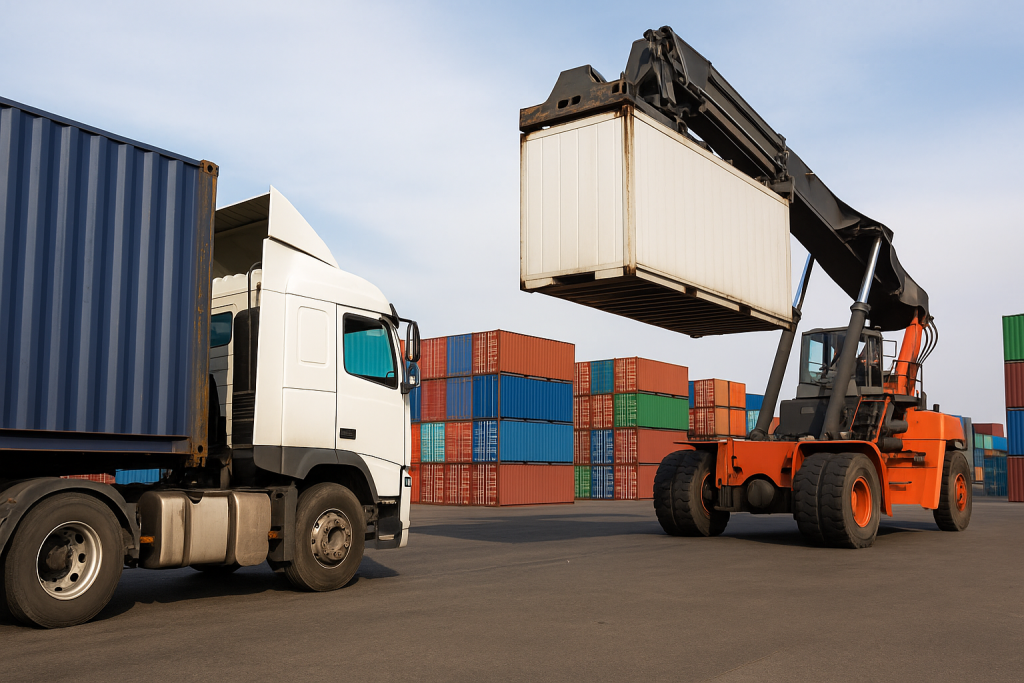By Martin Vassilev / 22 Oct, 2025
In today’s competitive logistics landscape, businesses must find the ideal balance between cost efficiency and delivery speed. Whether you’re shipping domestically across Canada or managing cross-border routes to the U.S., the decision between Less-than-Truckload (LTL) and Full-Truckload (FTL) shipping is critical. Choosing the right freight option can drastically impact your operational costs, customer satisfaction, and supply chain performance.
As more companies optimize their warehousing and fulfillment operations with partners like ByExpress Logistics, understanding the difference between LTL and FTL can help you make smarter, data-driven logistics decisions.
LTL (Less-than-Truckload) shipping is designed for freight that doesn’t require an entire trailer. Instead of dedicating a full truck, your shipment shares space with cargo from multiple businesses. Each shipper pays only for the portion of the trailer they use.
This model is ideal for small to medium-sized businesses or e-commerce stores that don’t have enough volume for full loads but still require professional logistics handling.
Cost Efficiency: You pay only for the space your freight occupies.
Flexibility: Great for small, frequent shipments.
Environmental Advantage: Consolidated loads mean fewer trucks on the road, reducing emissions.
ByExpress provides cost-optimized LTL solutions across major Canadian cities like Ottawa, Toronto, and Calgary, allowing businesses to ship efficiently without overpaying for unused space.
FTL (Full-Truckload) shipping means your shipment occupies the entire truck, regardless of whether it fills the space. This option is preferred for large, heavy, or time-sensitive shipments that need dedicated handling.
Faster Transit: Fewer stops and direct delivery routes.
Less Handling: Reduced risk of damage or loss since freight isn’t consolidated.
Ideal for High-Volume Shipments: Perfect for large retailers, manufacturers, or bulk suppliers.
FTL services are commonly used for cross-province and international routes, such as Calgary-Dallas logistics hubs, where speed and reliability are essential.
| Factor | LTL Shipping | FTL Shipping |
|---|---|---|
| Cost | Cheaper (shared cost model) | Higher cost (dedicated vehicle) |
| Speed | Slower (multiple stops) | Faster (direct route) |
| Shipment Size | Small to medium | Large or full loads |
| Risk of Damage | Slightly higher | Lower |
| Flexibility | Excellent for variable shipments | Best for predictable large volumes |
Both options have unique advantages depending on your logistics strategy and business needs.

LTL shipping is the perfect choice when:
Your shipment is under 10,000 pounds or doesn’t fill a full trailer.
You’re looking to reduce costs without sacrificing reliability.
Transit time isn’t the top priority.
You’re managing frequent shipments to multiple destinations.
If your company frequently ships small batches or e-commerce orders, LTL helps optimize resources while maintaining timely delivery schedules. Learn how to reduce logistics costs further by exploring 5 Ways to Lower Shipping Costs Without Compromising Speed.
FTL shipping is ideal when:
Your freight volume fills a truck (over 10,000 pounds).
Delivery speed is mission-critical.
Your shipment requires special handling or temperature control.
You’re transporting high-value goods and want minimal handling.
Many logistics professionals choose FTL routes for cross-border freight or time-sensitive deliveries like automotive parts, industrial machinery, or retail restocks. Explore Comprehensive Warehousing Solutions to integrate FTL into your long-term fulfillment plan.
Modern logistics now relies on AI, automation, and data analytics to optimize shipment decisions. Advanced platforms analyze routes, traffic patterns, and delivery windows to recommend whether LTL or FTL will deliver better ROI.
AI-driven logistics—like those discussed in How AI Is Transforming the Logistics Industry in 2025—can forecast shipment costs, reduce downtime, and increase accuracy. Predictive modeling tools allow businesses to automate carrier selection based on real-time data, improving both cost efficiency and on-time performance.
The decision between LTL and FTL often depends on what’s more important to your business—saving money or saving time.
LTL = Lower Cost, Moderate Speed
FTL = Higher Cost, Faster Delivery
A strategic mix of both options may be the best approach. Many companies use FTL for long-haul, time-sensitive loads and LTL for regular restocks or less urgent deliveries.
To optimize your balance, consider integrating your logistics plan with warehouse efficiency strategies such as How to Improve Warehouse Space Utilization for Maximum Efficiency.
For example, a retail chain distributing inventory to multiple stores across Ontario might use LTL shipping for weekly replenishments. Meanwhile, for seasonal or high-demand inventory, FTL shipping ensures stores are restocked quickly before peak sales periods.
Companies that combine these methods can reduce annual logistics costs by 15–25%, according to Transport Canada. Optimized freight management also contributes to environmental sustainability by reducing redundant trips and improving load efficiency.
Here are actionable steps to maximize freight value whether you choose LTL or FTL:
Consolidate Shipments: Combine small orders to form full loads when possible.
Use a 3PL Provider: Outsourcing logistics to companies like ByExpress ensures optimized load planning.
Leverage Route Optimization Tools: Use real-time tracking for route efficiency.
Monitor Fuel Surcharges: Track fluctuating rates to manage total shipping expenses.
Negotiate Volume Discounts: Consistent shipping volume can reduce per-mile costs.
For businesses seeking flexible scaling, explore on-demand warehousing options like How to Scale Your Business with On-Demand Warehousing.
LTL shipping typically produces lower carbon emissions per unit, as multiple shipments share the same route. However, FTL can sometimes be more eco-friendly if trucks travel direct routes with full loads.
Sustainability is a growing focus in modern logistics. The U.S. Environmental Protection Agency (EPA) recommends shippers assess both modes based on load utilization efficiency to minimize empty miles.
Companies can further enhance their green credentials through smart warehousing and route planning, as discussed in The Role of Green Logistics in Modern Warehousing.
By partnering with a 3PL logistics provider, businesses can seamlessly integrate both shipping models into one coordinated strategy. This ensures your freight decisions are based on real-time capacity, cost, and delivery deadlines.
At ByExpress Logistics, our experts use advanced analytics to determine the most efficient mode for each shipment—saving businesses both money and time while maintaining service excellence.
Generally, yes. LTL shipping is more cost-effective for small shipments since you pay only for the space used. However, for larger loads, FTL might offer better value per unit.
FTL is typically faster because it travels directly from pickup to delivery without multiple stops.
Absolutely. Modern LTL carriers, including ByExpress, provide real-time tracking systems for full visibility throughout the delivery process.
They can be, but FTL offers better protection due to less handling. If you choose LTL, ensure proper packaging and labeling.
Evaluate shipment volume, delivery frequency, cost targets, and urgency. You can also consult ByExpress Supply Chain Experts for customized guidance.
The decision between LTL vs. FTL shipping should align with your business’s scale, budget, and urgency. Both models play vital roles in modern logistics—LTL maximizes cost efficiency for smaller loads, while FTL ensures speed and safety for larger freight.
Whether you manage e-commerce fulfillment, B2B distribution, or cross-border logistics, partnering with a provider like ByExpress Logistics ensures you have the agility, insight, and technology to make the right choice every time.
For expert consultation or tailored freight solutions, contact ByExpress today and discover how to streamline your shipping strategy for 2025 and beyond.

“Thanks to Byexpress all my shipping and fulfillment costs are in line now”

“All my issues were solved by Byexpress team that I had with pervious 3pl provider.”

“Thank you Byexpress team could not done it without you guys.”

“Their integration and customer service were the key for me”

“Outstanding delivery service! The package was well-packaged, and
the delivery team was professional and courteous”

“Great and knowledgeable team to work with.”

Thanks, guys, for reducing my shipping rates
Ottawa Office
2411 Holly Lane
Ottawa, ON, K1V 7P2
Toronto Office
13-280 West Beaver Creek Road Unit #136
Richmond Hill, ON, L4B 3Z1
Alexandria Office
173 Kenyon Street West
Alexandria, ON, K0C 1A0
Montreal Office
4388 Saint-Denis Street Unit #200
Montreal, QC, H2J 2L1
California Office
155 North Riverview Drive
Anaheim Hills, CA, 92808
Call Us
Toll-Free: 1-866-744-7122
Local : 613-739-3000
Email Us
Multilingual Services










